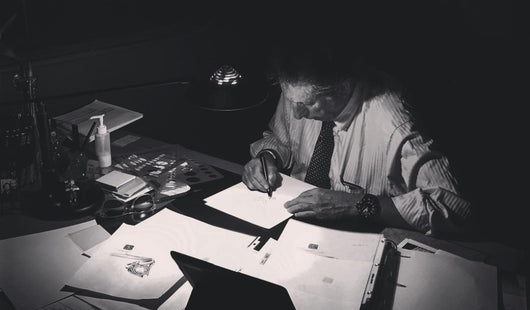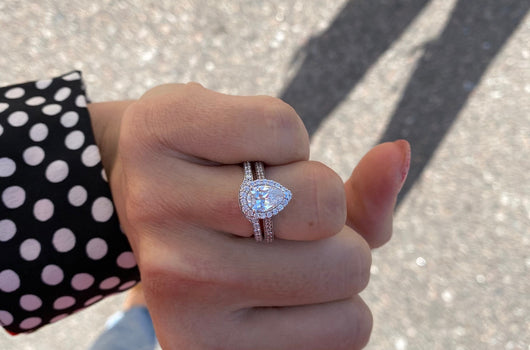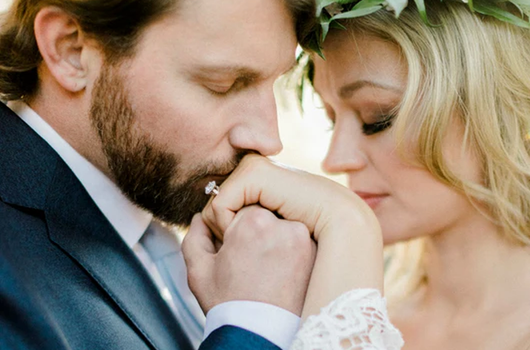Lab Grown Colored Diamonds: How are They Made?

While traditional white diamonds have always been popular, colored diamonds are becoming a trendy and meaningful choice for people who want to showcase their one-of-a-kind style. From soft blush pink to oceanic blue, each hue carries its own symbolism, making it easy to express individuality in engagement rings, fashion jewelry, and custom designs.
At the same time, lab-grown diamonds are having a moment as modern fashionistas seek affordable alternatives to naturally mined gemstones. Here’s everything you need to know about these radiant gemstones, along with some of our favorites from John Atencio’s celebrated collection.
How Do Natural Diamonds Get Color?
Whether clear or colored, natural diamonds form under intense heat and pressure deep within the Earth over billions of years. While most diamonds appear clear or white, trace minerals or elements introduced during crystallization can result in stunning natural color variations.

Here are some of the most common ways color forms in natural diamonds:
-
Blue: Caused by the presence of boron within the crystal lattice
-
Yellow/Orange: Caused by nitrogen, which absorbs blue light and creates warm hues
-
Green: Result of natural radiation exposure during formation
-
Purple/Violet: Caused by hydrogen or other trace elements
-
Pink/Red: The result of structural lattice distortions or pressure changes during growth
Even slight variations in pressure, temperature, radiation, and impurity concentrations can dramatically affect the resulting color. Because these variables must align in near-perfect ways, naturally colored diamonds are extremely rare—and extremely expensive.
Fortunately, this extraordinary natural process can now be safely replicated in a lab using advanced technology. The result? A colorful man-made diamond that’s chemically and optically identical to natural diamonds mined from deep within the Earth.
How Are Lab-Grown Diamonds Made?
Lab-grown diamonds start with a tiny diamond “seed” placed in a growth chamber. From there, one of two core methods is used:
1. High-Pressure, High-Temperature (HPHT)
Carbon material is subjected to extreme pressure (over 1.5 million psi) and temperatures (over 2,700°F). The diamond seed acts as a guide as carbon atoms bond and form a new crystal structure.
-
Advantages: Produces high-quality stones with excellent clarity
-
Disadvantages: More energy-intensive and less ideal for producing colored stones
2. Chemical Vapor Deposition (CVD)
CVD involves placing the diamond seed in a plasma chamber with carbon-rich gases (typically methane and hydrogen). Microwaves break down the gases into plasma, allowing carbon atoms to bond layer by layer, building the diamond.
-
Advantages: Greater control, better suited for introducing trace elements to create color
-
Disadvantages: Requires post-growth treatments for clarity or hue in some cases
Recent advancements in both methods have significantly improved yield, color variety, and clarity, making colored lab-grown diamonds more accessible and more dazzling than ever.
How Lab-Grown Diamonds Get Different Colors
By introducing specific trace elements and controlling environmental factors during or after diamond growth, labs can reliably produce diamonds in a wide range of hues.
Here’s how different colors are achieved:
-
Blue: Boron is introduced during the CVD or HPHT growth process
-
Yellow/Orange: Nitrogen is added, which interacts with carbon to create warm tones
-
Green: Created by exposing diamonds to controlled radiation after growth
-
Pink/Red: Achieved through post-growth high-pressure treatments
-
Purple/Violet: Hydrogen or other trace elements are absorbed during formation
These lab-controlled processes allow for exceptional accuracy in color and intensity, resulting in brilliant stones that rival their natural counterparts at a fraction of the price.
Colored Lab Diamonds vs. Natural Colored Diamonds
The key difference between colored lab diamonds and natural colored diamonds lies in their origin and value over time. Natural colored diamonds are exceptionally rare—formed deep within the earth over millions of years—and their scarcity makes them highly sought after by collectors and investors alike. As a result, they tend to retain or even appreciate in value. Lab-grown colored diamonds, while more affordable, are produced in controlled settings and lack the rarity that gives natural stones their enduring worth.
There are other key considerations when comparing these diamonds:
Lack of Rarity:
The value of natural-colored diamonds is rooted in their scarcity. Lab diamonds, by contrast, can be produced in volume, which diminishes their long-term rarity, emotional resonance, and resale value.
Depreciating Value:
Lab diamonds—especially colored ones—typically do not hold their value over time. As technology advances and production increases, prices continue to drop. This is especially relevant in investment-driven or legacy gift contexts.
Color Instability Concerns:
While labs can replicate color, certain hues—particularly blues and pinks—may be achieved through post-growth treatments like irradiation. These treatments can fade or shift slightly over time, especially if exposed to extreme heat or UV light, leading to concerns about color instability.
Visual Over-Perfection:
Some customers find that the precision of lab-grown diamonds can result in stones that appear too perfect or artificial—lacking the organic character or nuance that nature provides.
Environmental Claims Are Debated:
While often marketed as “eco-friendly,” lab-grown diamonds still require substantial energy—especially those made using HPHT methods. Unless the lab uses renewable energy, the carbon footprint may not be as low as presented.
How to Choose the Right Lab-Grown Colored Diamond
Whether you're selecting a lab-colored diamond for an engagement ring or a signature piece, here are a few considerations to guide your decision:
1. Color Preference & Symbolism
Choose a color that aligns with your personality, milestone, or relationship story.
-
Blue: Calm, loyalty, confidence
-
Pink: Romance, love, femininity
-
Yellow: Joy, creativity, optimism
-
Green: Renewal, growth, prosperity
-
Red: Passion, courage, strength
2. Setting & Metal Pairings
Consider contrast vs. complement when selecting your setting.
-
Cool tones (blue, violet) pair beautifully with white gold or platinum
-
Warm tones (yellow, orange, red) look stunning with yellow or rose gold
3. Budget Considerations
Colored lab diamonds vary in cost based on rarity and treatment methods. Pink, blue, and red are often more expensive due to added processes. Still, they are generally more affordable than natural colored diamonds of similar quality.
4. Quality Assessment
Apply the 4Cs (cut, color, clarity, carat). Also, be sure to consider color saturation and distribution, which affect brilliance and visual impact. Above all else, be sure to work with a trusted designer like John Atencio to ensure authenticity and quality certification.
Caring for Lab-Grown Colored Diamonds
Proper care ensures that your colored diamond remains radiant for years to come.
-
Clean regularly with warm water, mild soap, and a soft-bristled brush
-
Avoid harsh chemicals, bleach, or household cleaners
-
Do not use ultrasonic cleaners on color-treated diamonds
-
Store separately in a soft pouch or lined box to prevent scratches
John Atencio offers free inspections and professional cleanings for all John Atencio jewelry. Simply contact a nearby location to schedule an appointment.
FAQs About Lab-Grown Colored Diamonds
Q: Are lab-grown colored diamonds real diamonds?
A: Yes. Lab-grown diamonds are chemically, optically, and physically identical to natural diamonds.
Q: Are lab-grown colored diamonds more affordable than natural colored diamonds?
A: Absolutely. On average, they cost about 30% less than natural colored diamonds of comparable size and quality.
Q: Do lab-grown colored diamonds fade over time?
A: No. The color is stable. However, diamonds that undergo post-growth treatments should be protected from extreme heat or chemical exposure.
Q: Can lab-grown colored diamonds be customized?
A: Yes. Many jewelers, including John Atencio, offer customization options for hue, carat weight, cut, and setting.
Discover the Beauty of Colored Lab Diamonds
From romantic pinks to bold blues and everything in between, lab-grown colored diamonds offer dazzling brilliance and meaningful symbolism—all at an accessible price point.
John Atencio pairs these exceptional stones with meticulously crafted designs that reflect both artistry and sustainability. Explore his collection online or visit a nearby location to discover your perfect lab-grown colored diamond pieces for engagement rings and everyday wear.
Listen to our podcast episode on Lab Grown Diamonds.


